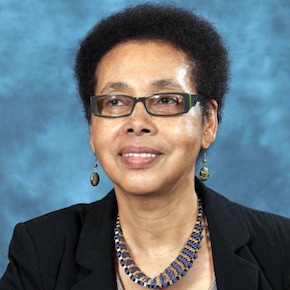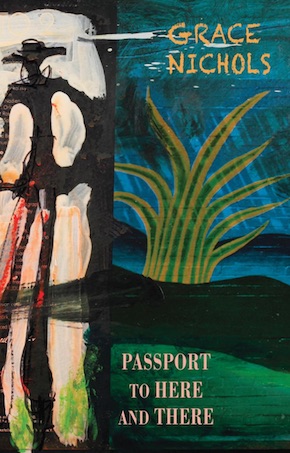Here and there
by Grace NicholsOne of the things we do as poets is to try to preserve experiences, people, places important to us, in an effort to save them from time’s erasure. In Passport to Here and There, I’ve been more conscious of this than in some of my other books and felt that a short introduction to my own background could make for some useful clarity.
Guyana (formerly British Guiana) gained its independence from Britain in 1966 after some 160 years of colonial rule. The only English-speaking country on the South American mainland, we’re much closer in terms of culture to the rest of the English-speaking cricket-playing Caribbean islands of Jamaica, Barbados, Trinidad, etc. and share with them an Atlantic coastline. But the history and myths of South America are still very much part of our imagination and consciousness, as is the influence of our own indigenous population, the Amerindians, who live in the forested areas of the country.
Before the British, Guyana was also colonised by the French and Dutch for varying periods. It was the Dutch 18th-century colonisers who built the much loved seawall to keep out the mighty Atlantic ocean along the coast. Georgetown and much of the coast are below sea level (as much as eight feet in parts) and the threat of the Atlantic, that sometimes comes over at high tide in little brown splashes, is a real one, especially in view of global warming.
The Dutch also laid out the city with straight streets running beside flowing canals (somewhat like Amsterdam). These, together with tree-lined avenues, earned Georgetown the name Garden City of the Caribbean. Georgetown itself lies within the county of Demerara, a name pregnant for most Guyanese since it not only evokes one of our main rivers, the Demerara, but also the brown sugar from the abundant canefields in that region.
Just under two years ago I made a return trip to Georgetown. It was my first time landing at Ogle, the smaller airport close to the city, instead of the main airport in its foresty setting of Timehri, some 25 miles from the capital. As the plane sailed over the Atlantic and the lit-up capital, I was overwhelmed by it all. It was like seeing the city of my girlhood for the very first time.
As the two weeks went by I rediscovered Georgetown in many small ways – in the super-abundance of vegetables and familiar fruits at the market squares, the museum which we visited as children, walking on the seawall, re-meeting cousins and of course just catching up with my sisters and brother as we recalled childhood memories with laughter and sometimes tears. Those two weeks inspired what I’ve decided to call ‘Snapshot Sonnets’, a coinage like the mingling of my English and Creole tongues, a playing with that most compulsive of forms, turning it towards a more anecdotal focus of memorable moments.
To this day I have this image of myself standing in brown water lit by the sun watching the shapes of fish go by below the surface. It is an enduring picture of myself caught in an innocent kind of cosmic bliss.”
I wouldn’t want to give the impression of Georgetown and Guyana being some kind of tropical idyll, as life for many Guyanese is a daily struggle and people still migrate when given the opportunity. Yet in recent years, a converse migration has been happening, since people from Venezuela, Brazil, Haiti, China, have all been settling in Guyana. And now that vast oil reserves have been found offshore (production has already started) who knows in what ways the country will change?
Growing up in Guyana (an Amerindian word that means Land of Many Waters), my childhood seems to span two distinct periods. My early years were spent in the small coastal village of Stanleyville, but we called it Highdam, an ironic name since it was very flat.
I don’t know whether it’s wishful thinking on my part, but I believe I owe the fact I write at all to that village where I spent my ‘small-girl days’, stealing down to the shore with my sisters and brother just before dawn to catch crabs; catching fish in old baskets in our own backyard whenever it rained heavily. It was a magical amphibious kind of landscape, prone to flooding, which was managed by man-made canals and dams and kokers, but the hot equatorial sun soon made it dry again once the kokers (a Dutch word for a kind of sluice) had drained away the water.
To this day I have this image of myself standing in brown water lit by the sun watching the shapes of fish go by below the surface. It is an enduring picture of myself caught in an innocent kind of cosmic bliss. For me the fish is like a living poem, a symbol of mystery that goes beyond itself and I subscribe to the English poet Ted Hughes’ view that as a poet you have to be able to fish your ideas from the sea of your unconscious.
My own love affair with language began with English nursery rhymes and fairy tales told by my mother, from Hansel and Gretel to Ali Baba and the forty thieves as well as our own frightening folk tales and jumbie (ghost) stories and nonsensical schoolyard rhymes.
Having moved to Georgetown at the age of eight, I joined the Public Free Library and was the proverbial bookworm. Enid Blyton, Richmal Crompton’s William books (I adored William and his many escapades), Nancy Drew and Hardy Boys mysteries, were all grist for my young devouring imagination. The librarians tried in vain to get us to read more literary books but we simply went for what we liked.
I also liked dipping into my father’s books of poetry. My father was a headmaster and our home was never short of books including those old Royal Readers he used at school with poems about soldiers dying on battlefields far from home, not to mention that boy who stood on the burning deck whence all but he had fled, experiences far removed from my world.
Nevertheless I remember being moved, not only by the emotions but by the images and music of the words. Later on in schools we had to study, as any student in England would have done, the works of Shakespeare, Keats, Wordsworth, Jane Austen, among others. It was only after coming to England that I came face to face with Wordsworth’s iconic daffodil, my favourite English flower by far.
Passport to Here and There attempts to give voice to the two cultures in terms of experience and textures that have helped to shape me as a person and as a poet, namely Guyana (within its Caribbean/South American context) and England, and the historical bridges between them.
I’ve always been inspired by the actual physical landscape and now that I’ve been living in England for much longer than I’ve lived in Guyana, my sense of identity, my new-world-self has grown much more fluid. My Guyana-eye and Caribbean sensibility still filters my work but the Sussex landscape, the white chalk cliffs, the rolling downs which I enjoy walking on, the pagan mystery of the ancient hills, are all part of me now.
from the preface to the collection Passport to the Here and There (Bloodaxe Books, £9.95)
 Grace Nichols was born in Guyana and has lived in Britain since 1977. Her first collection, I is a Long Memoried Woman (1983) won the Commonwealth Poetry Prize. Her later poetry collections, published by Virago, include The Fat Black Woman’s Poems (1984), Lazy Thoughts of a Lazy Woman (1989), Sunris (1996), winner of the Guyana Prize, and Startling the Flying Fish(2006), along with several poetry books for younger readers, including Come on into My Tropical Garden (1988), Give Yourself a Hug (1994), Everybody Got a Gift (2005) and Cosmic Disco (2013). Passport to Here and There, a 2020 Poetry Book Society Special Commendation, is her fourth book with Bloodaxe, after Picasso, I Want My Face Back (2009), I Have Crossed an Ocean: Selected Poems (2010) and The Insomnia Poems (2017). She lives in Sussex with the poet John Agard and their family.
Grace Nichols was born in Guyana and has lived in Britain since 1977. Her first collection, I is a Long Memoried Woman (1983) won the Commonwealth Poetry Prize. Her later poetry collections, published by Virago, include The Fat Black Woman’s Poems (1984), Lazy Thoughts of a Lazy Woman (1989), Sunris (1996), winner of the Guyana Prize, and Startling the Flying Fish(2006), along with several poetry books for younger readers, including Come on into My Tropical Garden (1988), Give Yourself a Hug (1994), Everybody Got a Gift (2005) and Cosmic Disco (2013). Passport to Here and There, a 2020 Poetry Book Society Special Commendation, is her fourth book with Bloodaxe, after Picasso, I Want My Face Back (2009), I Have Crossed an Ocean: Selected Poems (2010) and The Insomnia Poems (2017). She lives in Sussex with the poet John Agard and their family.
Read more
@BloodaxeBooks
Author portrait © Mike Park
Cover artwork: Detail from Dub Factor: White Christmas I (2008–9) by Victor Davson


